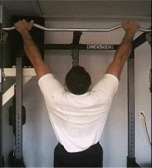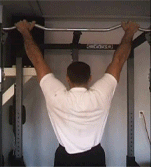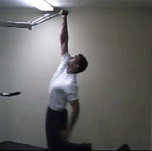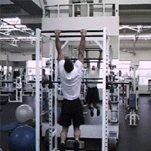.gif)
Pull-up (exercise)
Encyclopedia
A pull-up is an upper body compound pulling exercise where the body
is suspended by the arm
s, gripping something, and pulled up with muscular effort. As this happens, the wrists remain in neutral (straight, neither flexed or extended) position, the elbows flex and the shoulder adducts and/or extends to bring the elbows to or sometimes behind the torso.
A traditional pull-up relies on upper body strength with no swinging or "kipping" (using a forceful initial movement of the legs in order to gain momentum). The exercise often targets the latissimus dorsi muscle in the back along with many other assisting muscles.
This has been standardized with world record organizations such as Guinness World Records and recordholders.org.
A "chin up" is named after either bringing the chin up to touch the bar, or alternatively, bringing it up and over the bar. As this is more easily done with a supinated grip, the term chin-up has been associated with doing pull-ups with an underhand (supinated, palms facing toward) grip. This new usage of chin up (which has a completely different meaning from the original one, and nothing to do with one's chin
) has led some to use "pull up" in a more restricted use to refer to its opposite, pulling with a prone grip.
Variations of pull ups, beyond being named for their grip, can also be named based on how high the body rises, by naming it after the body part that either comes into contact with or passes over the top of the bar. A "chest-up" or "sternum-up" for example, indicates that the chest or sternum meets the bar, requiring extra scapular adduction and depression.
What can also differ is the width of the grip. When grabbing and holding the bar during the pull-up, the hands can be apart at shoulder-width, but also go beyond that. This will make the pull-up more difficult, but also limit the range of motion when compared to the shoulder-width grip.
The posterior deltoid muscle
s and teres major muscle
s are extensor/adductor muscles which attach to the scapulae. The lower trapezius and pectoralis minor are involved as a scapular depressors. The pec minor works in conjunction with the levator scapulae muscle
s and rhomboid muscle
and to downwardly rotate the scapulae, while the serratus anterior pulls forward to rotate the scapula downward and stabilize the shoulder during descent. If one leans back during a pull up, the rhomboids also work with the lower traps to retract/adduct the scapulae.
Muscles which flex the elbow joint are also involved in providing ideal leverage for shoulder extension/adduction. The biceps brachii muscle
is involved in dynamic stabilization; it shortens as the elbow flexes yet lengthens as the shoulder extends. It is strongest with a supine grip (what people recently identify with "chin up"). The brachialis and brachioradialis
attach to the humerus rather than the scapulae so they only shorten as the pull up is performed. They are relied on even more heavily with a prone grip which limits the biceps' involvement.
The rectus abdominis, erector spinae
, transverse abdominis and internal obliques/external obliques are used to hold the hips and rib cage together and support the spinal ligaments in resisting the traction of gravity.
Pelvic tilt and the orientation of the legs can alter which of the core muscles are used to bear their weight. If the legs are lifted to the front and the pelvis tilts posterior, the rectus abdominis (with aid from the psoas) bears more weight. If the legs are lifted to the back and pelvis is tilted anterior, the erector spinae (with aid from the lats) bear more weight. Raising the legs and one side of the pelvis laterally will result in more weight born by that side's obliques.
give advice such as "care should be taken not to unduly put stress on your shoulder during this exercise."
Bodyweight
Additionally weighted
Body
With regard to living things, a body is the physical body of an individual. "Body" often is used in connection with appearance, health issues and death...
is suspended by the arm
Arm
In human anatomy, the arm is the part of the upper limb between the shoulder and the elbow joints. In other animals, the term arm can also be used for analogous structures, such as one of the paired forelimbs of a four-legged animal or the arms of cephalopods...
s, gripping something, and pulled up with muscular effort. As this happens, the wrists remain in neutral (straight, neither flexed or extended) position, the elbows flex and the shoulder adducts and/or extends to bring the elbows to or sometimes behind the torso.
A traditional pull-up relies on upper body strength with no swinging or "kipping" (using a forceful initial movement of the legs in order to gain momentum). The exercise often targets the latissimus dorsi muscle in the back along with many other assisting muscles.
Etymology
The name refers to pulling one's body up. Pull-ups are associated with utilizing an overhand (pronated, palms facing away) grip by many organizationsThis has been standardized with world record organizations such as Guinness World Records and recordholders.org.
A "chin up" is named after either bringing the chin up to touch the bar, or alternatively, bringing it up and over the bar. As this is more easily done with a supinated grip, the term chin-up has been associated with doing pull-ups with an underhand (supinated, palms facing toward) grip. This new usage of chin up (which has a completely different meaning from the original one, and nothing to do with one's chin
Chin
In the human anatomy, the chin is the lowermost part of the face.It is formed by the lower front of the mandible.People show a wide variety of chin structures. See Cleft chin....
) has led some to use "pull up" in a more restricted use to refer to its opposite, pulling with a prone grip.
Variations of pull ups, beyond being named for their grip, can also be named based on how high the body rises, by naming it after the body part that either comes into contact with or passes over the top of the bar. A "chest-up" or "sternum-up" for example, indicates that the chest or sternum meets the bar, requiring extra scapular adduction and depression.
Grips
Pull-ups (including chins) can be done with a supinated, neutral or pronated grip. Grips may match each other or be different. Grips may also rotate throughout the movement, such as by doing them on rings or rotating handles. The range of motion used by trainers can vary. The fullest possible range is with straight arms overhead (elbow directly above shoulder), to pulling when the arms are at the sides (elbow directly below shoulder). People sometimes only train portions, such as avoiding locking out the arms at the bottom, or stopping when the head/chin/neck touch the bar. Positions within the range are also trained isometrically, as in flexed-arm and straight-arm hangs for time.What can also differ is the width of the grip. When grabbing and holding the bar during the pull-up, the hands can be apart at shoulder-width, but also go beyond that. This will make the pull-up more difficult, but also limit the range of motion when compared to the shoulder-width grip.
Muscles used
The latissimus dorsi ("lats") and the lower sternal fibers of the pectoralis major are involved in extending/adducting the arm from the overhead position. These muscles do not connect to the scapulae, and their use reduces the need for muscles which attach to them.The posterior deltoid muscle
Deltoid muscle
In human anatomy, the deltoid muscle is the muscle forming the rounded contour of the shoulder. Anatomically, it appears to be made up of three distinct sets of fibers though electromyography suggests that it consists of at least seven groups that can be independently coordinated by the central...
s and teres major muscle
Teres major muscle
The teres major muscle is a muscle of the upper limb and one of six scapulohumeral muscles. It is a thick but somewhat flattened muscle, innervated by the lower subscapular nerve .-Origin and insertion:...
s are extensor/adductor muscles which attach to the scapulae. The lower trapezius and pectoralis minor are involved as a scapular depressors. The pec minor works in conjunction with the levator scapulae muscle
Levator scapulae muscle
In human anatomy, the levator scapulae is a skeletal muscle situated at the back and side of the neck. As the name suggests, its main function is to lift the scapula.-Origin and insertion:...
s and rhomboid muscle
Rhomboid muscle
The rhomboid muscles, often simply called the rhomboids, are rhombus-shaped muscles associated with the scapula and are chiefly responsible for its retraction. There are two rhomboid muscles:* Rhomboid major muscle* Rhomboid minor muscle...
and to downwardly rotate the scapulae, while the serratus anterior pulls forward to rotate the scapula downward and stabilize the shoulder during descent. If one leans back during a pull up, the rhomboids also work with the lower traps to retract/adduct the scapulae.
Muscles which flex the elbow joint are also involved in providing ideal leverage for shoulder extension/adduction. The biceps brachii muscle
Biceps brachii muscle
In human anatomy, the biceps brachii, or simply biceps in common parlance, is, as the name implies, a two-headed muscle located on the upper arm. Both heads arise on the scapula and join to form a single muscle belly which is attached to the upper forearm...
is involved in dynamic stabilization; it shortens as the elbow flexes yet lengthens as the shoulder extends. It is strongest with a supine grip (what people recently identify with "chin up"). The brachialis and brachioradialis
Brachioradialis
Brachioradialis is a muscle of the forearm that acts to flex the forearm at the elbow. It is also capable of both pronation and supination, depending on the position of the forearm...
attach to the humerus rather than the scapulae so they only shorten as the pull up is performed. They are relied on even more heavily with a prone grip which limits the biceps' involvement.
The rectus abdominis, erector spinae
Erector spinae
The Erector spinæ is a muscle group of the back in humans and animals. It is also known as sacrospinalis in older texts. A more modern term is extensor spinae, though this is not in widespread use. The name of the muscle is pronounced e-rec-tor speen-aye, or e-rec-tor spinae-ee.It is really not...
, transverse abdominis and internal obliques/external obliques are used to hold the hips and rib cage together and support the spinal ligaments in resisting the traction of gravity.
Pelvic tilt and the orientation of the legs can alter which of the core muscles are used to bear their weight. If the legs are lifted to the front and the pelvis tilts posterior, the rectus abdominis (with aid from the psoas) bears more weight. If the legs are lifted to the back and pelvis is tilted anterior, the erector spinae (with aid from the lats) bear more weight. Raising the legs and one side of the pelvis laterally will result in more weight born by that side's obliques.
Safety
Organizations like the American Council on ExerciseAmerican Council on Exercise
The American Council on Exercise is a nonprofit fitness certification and education provider.Established in 1985, ACE now operates as a full-service entity with a staff of more than 40...
give advice such as "care should be taken not to unduly put stress on your shoulder during this exercise."
List of some variations
| Example | Type |
|---|---|
 |
Standard Standard dead-hang pull up is grasped with an overhand/underhand/alternative-hand grip. Then the body is pulled up until the chin clears the bar, and finished by lowering the body until arms and shoulders are fully extended. Stricter standards would only consider a full repetition to be one in which the elbows pass behind the coronal plane. |
 |
Weighted Weight is added using a dipping belt, or grasping a dumbbell with the feet, or weight vest/shorts |
 |
Behind-the-neck pull-up The chin is dropped. The goal of the pull-up is to touch the bar with the back of the neck. |
 |
One arm A one arm pull-up is performed by grasping the bar with only one hand while pulling up. This is difficult due to the considerable strength required. |
 |
Muscle-up The muscle-up is performed by pulling up, but rather than stopping with the chin or chest touching the bar, the arms are straightened, raising the body above the bar. Generally the initial pull-up uses an overhand grip to make the switch easier and is more explosive in order to take advantage of momentum Momentum In classical mechanics, linear momentum or translational momentum is the product of the mass and velocity of an object... from the first half of the exercise to aid in the second half. |
Supine row Supine row The supine row is an exercise in weight training. This exercise primarily works the muscles of the upper back, these muscles are the Trapezius and Latissimus dorsi, the supine row also works the Biceps as a secondary muscle group... Sometimes called an "Australian pull-up", "reverse push-up", "inclined pull-up" or "inverted row", this is performed with the bar 2 to 3 feet off the floor. The user lies on the ground under the bar, face-up, and grasps the bar with extended arms. The exercise is performed by pulling the chest up to the bar. The body is held in a rigid plank position while the heels remain on the floor. |
|
Mixed grip One hand is placed in the overhand (pronated) position and the other is placed in the underhand (supinated) position to provide variation on the elbow flexors used. |
See also
- Chin-upChin-upThe chin-up is a strength training exercise. The verb chinning means to do them. People frequently do this exercise with the intention of strengthening muscles such as the latissimus dorsi and biceps, which extend the shoulder and flex the elbow, respectively.It is a form of pull-up in which the...
- Chin-up barChin-up barChin-up bars are playground equipment that were once ubiquitous on children's playgrounds. They are still important in the adult equivalent of a playground, the Par course. A chin-up bar is simply a smooth horizontal metal bar, often a pipe, held solidly above ground by a wooden or metal frame...
- Pulldown exercisePulldown exerciseThe pulldown exercise or the cable lat pulldown is a strength training exercise designed to develop the latissimus dorsi muscle. It performs the functions of downward rotation and depression of the scapulae combined with adduction and extension of the shoulder joint.-Muscles:The standard pulldown...
- Push upPush UpThis article is about the single. For the body exercise, see Push-upPush Up is a single by British group Freestylers, featuring Theo, released in 2004. It was a hit mainly in Belgium and Australia, as well as the Netherlands....
External links
- Pull-ups, American Council on ExerciseAmerican Council on ExerciseThe American Council on Exercise is a nonprofit fitness certification and education provider.Established in 1985, ACE now operates as a full-service entity with a staff of more than 40...
- United States Marines fitness guide that describes pull ups and how they can be done with a supine or prone grip
- Specific Guidelines Pack for "Heaviest Weighted Pull-up" by Guinness World Records.
- World record holders for Pull-ups and Chin-ups
- Swiss Pull-up Association
Bodyweight
Additionally weighted
- Weighted Pull-up
- Weighted Chin-up
- Weighted Pull-up (neutral grip)
- Weighted Close Grip Chin-up
- Weighted Underhand Chin-up
Guinness World Records
- Most pull ups in one hour - 1,009 by Stephen Hyland (UK) 1 Aug 2010
- The heaviest weighted pull up - 206.2 lbs by Steven Proto (USA) 9 July 2011
RecordHolders.Org
- Most Pull-ups in 3 mins - 100 Ngo Xuan Chuyen (VIE) 1988
- Most pull-ups in 30 mins - 543 Stephen Hyland (GBR)5 Jul 2010
- Most pull-ups in 6 hours - 2,456 Guy Schott (USA) 28 April 2007
- Most pull-ups in 24 hours - 3,165 Jason Armstrong (USA) 30 May 2010

